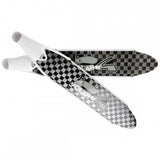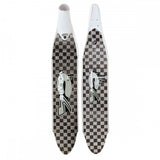TECHNICAL DATA
MATERIAL: 100% carbon fiber TR50 HYPERTECH REFLECT
BLADE DIMENSION: 1000 x 197 mm
BLADE HARDNESS: 25 soft – 30 medium
WATER RAILS: variable Tunnel ( with a patent )
FINS ANGLE: 29°blade + 3°footpoket = 32°
FINS WEIGHT: from 600gr. up to 730 gr.
FOOT POCKET WEIGHT: 316 gr. in size 40/41
300 FOOTPOCKET SIZES (White):
European sizes: 36/37 - 38/39 - 40/41 - 42/43 - 44/45 - 46/47 – 48/49
US/Canada sizes: 4/4.5 – 5.5/6 – 7/8 – 8.5/9 – 10/11 – 11.5/12.5 – 13/14
MADE in ITALY
C4 has over thirty years experience in designing and manufacturing advanced carbon fiber equipment, in Italy. Our history is at the base of our brand success.
300: A UNIQUE ANATOMICAL SHAPE
The 300 unique footwear anatomy is obtained by superimposing the shapes of our right and lef anatomical foot pockets, the Mustang, with their 3°angle. Angle also maintained in the 300 foot pockets. The 300 modular foot pocket anatomic shape is designed to tightly fit to the feet so that energy is transmitted on all foot areas. Thanks to this anatomical design, the energy dispersion caused by unwished gaps between foot and footpockets, is the least possible. Force is naturally applied with the least effort. Fitting and comfort are extremely high thanks to the innovative material used to manufacture the 300 foot pocket shoes which also allows for a 7 time higher resistance compared to other traditional materials.
300: HYDRODYNAMICS
Hydrodynamics: an efficient performance is based on resistance reduction. 300 fins elegant shape could have easily been designed by lines of water flowing on your feet without interruptions and only ongoing smooth lines. Hydrodynamics is key to reduce divers’ fatigue and these footpockets shiny look combines beauty and performance.
300: SAFETY & TIME
Blades are connected to the foot pockets by two special Hilo screws, for a better mechanical seal and energy transmission. This mechanical solution, in addition to making blades replacement much easier, prevents blades from being over stressed.
D.P.C. Double Parabolic Curve
The blade works best when it bends completely? From heel to toe !! This is possible thanks to the double parabolic curve of blades, from heel to toe. A neutral intermediate bottom and two progressive declining curves. Thus it fully exploits the shovel and its elasticity.
29° + 3° = 32°
The design of modern fins is mainly focused on achieving a better performance by increasing the total angle between the foot and the fin blade. The foot pocket blade angle must be amplified. In case of a low angle, stiffness of blades will result in fins with a reduced performance. Softer blades with a wider agle will result instead, in stiffer fins. C4 footpockets do not create this problem; all C4 anatomical footpockets have a 3° angle. The blade angle is 29°, a value much used on modern fins which determines a greater preload, making the blade more reactive. Such 29° solution, reaches an angle of 32° thanks to the 3° angle of the patented C4 footpockets providing for an excellent kinematic performance.
ONCE UPON A TIME
In the past, to dive at very high depths, fin blades, longerons and foot soles had to be extremely stiff. This was the only way to achieve performing fins. Nowadays, blades are soft and performing, therefore modifying the divers’ athletic movement as less effort is required. This is diving, not skiing and not even climbing, where strength is key. Modern blades can bend under few hundreds grams. Stiff foot soles and footpockets are not necessary any longer as they even limit divers’ performance. C4 goal has always been to create products which allow for a fluid and constant movement in water. As a matter of fact, footpockets must serve divers helping them to freely move their feet. This is why C4 300 foot pockets’ calibrated stiffness, in combination with modern soft and angled blades, offer an amazing swimming experience. This is what modern divers require, nothing more than that: a really efficient performance.
Big Square HYPERTECH
Lighter and stronger, more responsive and safer. These composite blades are made with carbon fabric HYERTECH – Big Square. The use of the innovative method of production, Spread Tow instead of yarn, optimizes the structure. Less intersection between the fibers and less ondulations greatly reduce the absorption of energy. Using fins this means blade's great reactive elasticity, what else?
FLAP
Should the fin blade bend completely? Even at the tip? To work best this seems obvious, but water rails tend to make blades quite stiff especially in their thinner areas. The flap is the solution. It allows full flex torsion of the blade, even at the tip, helping to centralize the fluids and therefore reducing turbulence. More flex torsion and less turbulence result in greater speed.
WATER RALIS TUNNEL
Ancient Romans, 2000 years ago, used to say: “In media stat virtus”, virtue stays in the middle. TUNNEL water rails (patented by C4 ) stand between EVO water rails for fishing and CONSTANT water rails for freediving. They are suitable for long and soft blades. They are designed to create a partial “tunnel” that better directs water when kicking. Preferably to be used with 300 foot pocket fins




